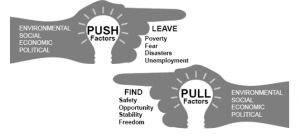Because of an overwhelming week of health issues, personal commitments, and pure exhaustion, our research has taken a back seat this week. Amy and I did make a plan for our website, organize our ideas, and create a new document for us to draft up web content.
I have been looking at the Mexican history portion of our first Prezi for the website, and found that we actually hadn’t compiled any resources for this portion of our research or for the Mexican process of migration. It’s a good thing Amy and I both study Latin American Studies because we really did have a full arsenal of literature. The following paragraph is a draft of some web content that has come from a historical monograph and a lecture from UMM intrum professor Pedro Quijada given in my Latin American Immigration course last year.
Nevitte, Neil. The North American Trajectory: Cultural, Economic, and Political Ties among the United States, Canada and Mexico. Routledge, 2017.
Quijada, Pedro. “Mexican Immigration and The Chicano Movement.” Lecture, Latin American Immigration, University of Minnesota Morris, Morris, Minnesota, February 16, 2016.
Some scholars agree that there have been three large waves of Mexican immigration to the United States. The first being the after the Mexican Revolution. The second wave was after World War two called the Bracero Program which was also a key factor in the sudden growth of the Civil Rights Movement in the United States Southwest. The third wave of Mexican immigration to the United States was after the mid 1960’s at the height of the border industrialization program. 1965 marked the end of the Bracero Program, but Mexican employment on the border hardly decreased. These waves greatly impacted the economic relations between Mexico and the United States and when the North American Free Trade Agreement began in 1994, the blend of the Mexican North, United States South, and their economies became apparent. Over time, as the industries and economies of these countries have converged to be dependent on one another. The geographical proximity, similarities in industry, and a unique economic dependence between Mexico and the United States has made for an interesting history of migration that has impacted individuals and industry even all the way to Minnesota.
Digital image. Push and Pull Factors of Mexican Migration. 2017. Accessed October 10, 2017. http://www.emigration.link/push-pull-factors-mexican-migration.htm.
There are often very simplified explanations of factors that influence the migration of people, goods, and industry that have long term implications on the perceptions of migration across the US, Mexican Border. This example clearly outlines a few of the individual factors that are vital to the migration process, but they omit the resources to begin a discussion on immigration. As noted above, the main influencing factors are environmental, social, economic, and political.
Amy and I hope to fill the gap between the omission of images and rhetoric like this by bringing to light to history of Morris and the current experiences of Midwestern immigrants.

Good blog post Joy. You are correct in that there is a great deal of historiography ‘out there’ on Mexican migration to the USA. The introductory chapters to many books take up that literature to differing levels of depth. The Bracero Program has one of the best digital website around: http://braceroarchive.org/. There might be some information there of use to you but if not it is an inspiration.
(The image that you provide here — what is the origin?)